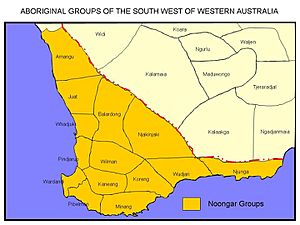Mineng facts for kids
The Mineng people, also known as Minang, Menang, or Mirnong, are an Indigenous group from Noongar country. They live in the southern part of Western Australia.
Contents
Who are the Mineng People?
The name Minang comes from the word minaq, which means "south." This suggests the Minang people were known as "southerners." They are an important part of the larger Noongar community.
Mineng Traditional Lands
The Mineng people traditionally lived on about 4,900 square miles (12,700 square kilometers) of land. Their territory stretched from King George Sound north to the Stirling Range.
Their lands included places like Tenterden, Lake Muir, and the Shannon River area. Along the coast, their territory went from West Cliff Point to Boat Harbour and the Pallinup. Other important places in their country were Mount Barker, Nornalup, Wilson Inlet, and the Porongurup Range.
Mineng Community Groups
The Mineng people were organized into different groups called hordes. One group from the north was known as the Munite. This name might refer to the "White Cockatoo" tribe, which is mentioned in other historical records.
Early Encounters with Europeans
Norman Tindale, a famous anthropologist, wrote about a possible meeting between the Mineng people and Europeans. This event might be described in Charles Darwin's book, The Voyage of the Beagle. Darwin visited King George Sound for eight days. He described a special gathering by the "Cockatoo tribe":
A large group of Indigenous people, called the White Cockatoo men, visited the settlement. They, along with the King George's Sound tribe, were offered rice and sugar. This encouraged them to hold a corroboree, which is a big dancing party.
As it got dark, small fires were lit. The men began painting themselves white with spots and lines. When everything was ready, big fires kept burning. Women and children gathered around to watch. The Cockatoo and King George's men formed two separate groups. They often danced in response to each other.
Their dancing involved running sideways or in a line into an open space. They stamped the ground with great force as they moved together. Their heavy footsteps were joined by a kind of grunt. They also beat their clubs and spears together. They made various other movements, like extending their arms and wiggling their bodies.
It was a very wild and powerful scene. To the Europeans, it seemed to have no clear meaning. However, the Indigenous women and children watched with great joy. These dances might have originally shown actions like wars and victories.
One dance was called the Emu dance. In this dance, each man bent his arm like the neck of an emu bird. In another dance, one man pretended to be a kangaroo eating in the woods. Then, a second man crawled up and pretended to spear him.
When both tribes danced together, the ground shook from their heavy steps. The air filled with their wild cries. Everyone seemed very happy. The group of dancers, seen by the light of the blazing fires, moved in a powerful way. It was a perfect example of a festival among these people.
Darwin noted that he had seen many interesting scenes of Indigenous life in Tierra del Fuego. But he felt this was one of the most lively. After the dancing, everyone formed a big circle on the ground. The boiled rice and sugar were shared, which everyone loved.
Mineng Culture and Music
One of the most famous singers among the Noongar people was a Mineng man named Nebinyan. He worked for many years on a whaling ship. He sailed in the coastal waters of the Indian Ocean and the Great Australian Bight.
Nebinyan became well-known for the narrative songs he created about his experiences. One special song about a whale hunt was heard by Daisy Bates. She wrote down some details, but sadly, she didn't record the song itself.
Another performance by Nebinyan was also greatly admired. He shared a dance his grandfather had created. This dance mimicked what his grandfather had seen when Matthew Flinders first arrived on the southern coast a century earlier.
Mineng People Today
Today, most Mineng people live in and around Albany. This area is on the South Coast of Western Australia.
Other Names for Mineng
The Mineng people have been known by several other names, including:
- Mean-anger, Meernanger
- Meenung (a name used by the Koreng people)
- Minnal Yungar ("southern men")
- Minung, Meenung
- Mirnong
- Mount Barker tribe
Some Mineng Words
Here are a few words from the Mineng language:
- janka (whiteman)
- mam (father)
- moking (wild dog)
- nginung, ngyank, nonk (mother)
- nop, kooling (baby)
- twert (tame dog)


